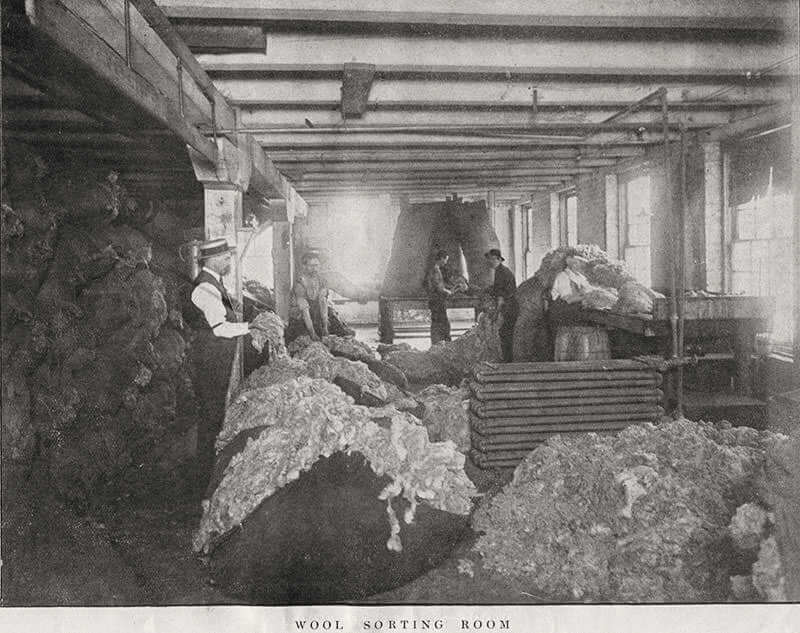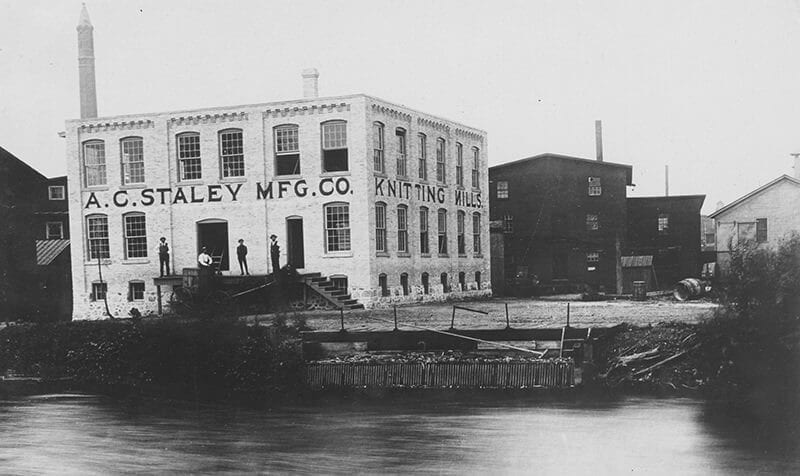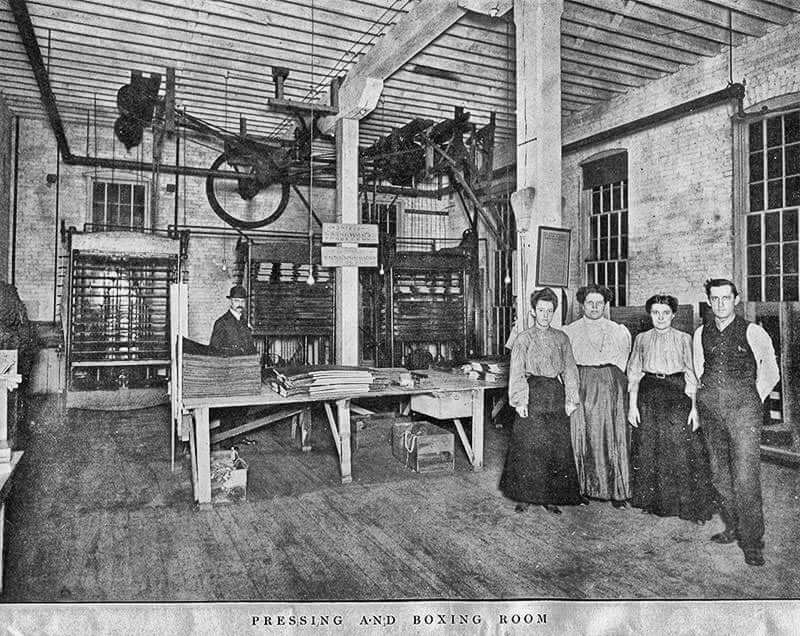Stephenson Underwear Mills
Location: 400 E. Colfax Ave., South Bend
In 1855, A.C. Staley, a tanner, and Jeremiah Sowry, a wool carder, started a small wool business for picking, carding, and weaving the wool of local farmers. Evidently, Staley was always professionally addressed by his initials, but his first name was Alexander.
It was hoped that this new business would open a new channel of trade, which would pour wealth into the Plymouth, Indiana community; but within eight years, in 1863, the firm of A.C. Staley and Jeremiah Sowry moved to South Bend. Jeremiah did not move, so A.C. reestablished the mill business with the help of his older sons. He settled on the East Race, and his business was the first structure to contain machinery that was operated by water from the race.
The first floor of his three-story building contained several coloring tubs and scouring machines, a heating boiler, and coal rooms. The wool was sorted into different grades and scoured on this floor. It was then passed up to the third floor to be carded. The wool was processed through the two sets of three carding machines where it was received from a hopper, weighed, carded, and rolled out in continuous rolls ready for the spinners. The second floor held the twisting, spinning, and weaving machines. All the yarn was spun on a machine that was called a “mule.” The “mule” had 500 spindles and occupied the full length of the building. Each of the 500 spindles did four to five times as much work as a spinning wheel. The attic was used for the storing of wool. During the wool season, the storage room was crowded to its full capacity; but it was not entirely filled with wool from the St. Joseph County area. The markets of South Bend did not furnish enough of the fine or medium grades of wool that the Staley Mill needed, so it received wool from both the markets of St. Louis and Chicago.
In 1881, the Staley Mill became A.C. Staley and Sons when Mr. Staley took his three sons, George C., Marion B., and Byron A., into partnership. The firm devoted its full attention to the manufacture of yarns and allowed its two weaving machines to remain almost entirely idle. The Staley Mill marketed its yarn not only in the state of Indiana, but for numerous parts of Michigan, Illinois, Wisconsin, Minnesota, Iowa, and Ohio. Most of their yarn was purchased by retailers; but large amounts of it were bought by manufacturers.
The Staley Mills once again underwent a change in 1888 and was incorporated under the name of the A.C. Staley Manufacturing Company. The incorporators were A.C. Staley, his son, Marion B., William H. Longley, a former mayor of South Bend, and R. Stewart Pigot. Following A.C. Staley’s death in 1889, Marion B. Staley and the other stockholders took over the firm. In the same year, William Mack, William H. Mack and the Stephenson brothers gained an interest in the business and became connected with its management. Shortly afterwards, Longley and Pigot left the firm, and later William and William H. Mack also disposed of their interests in the corporation to Clinton B., A.H. “Del,” Burr C., and Frank A. Stephenson. At the time of incorporation, the firm of A.C. Staley Manufacturing Company made men’s wool underwear.
The firm prospered and sold its goods in all the principal towns from western New York and Pennsylvania to the Pacific coast and from the Canadian line to the Ohio River. Its entire production line was sold before May 1st of each year, and the mills were run on a 24-hour schedule for the balance of the year. These garments were sold to retail merchants, thus eliminating the ‘middle man’. The mills employed men, women, and children and operated continuously even during the financial panic years of 1893-1896.
The company had grown from its original frame woolen mill to an extensive plant of six brick buildings. Both steam and waterpower were used, and the company owned and operated its own electric lighting plant. It attempted to keep up with current improvements in technology and installed electrical appliances and machinery as they became available.
In 1907, the mills of A.C. Staley once again underwent a change when the Stephenson brothers became the sole stockholders and managers of the plant. Clinton, “Del”, Burr, and Frank Stephenson had risen from the ranks of sales agents to become the owners of the A.C. Staley Manufacturing Company. In the same year, the company became the Stephenson Underwear Mills.
The new firm did very well and was especially prosperous during World War I because of the large contracts it received for war garments. Its Union Suits and Victoria undergarments for the ladies were sold all over the United States and made from the wool of sheep in the mountain and Pacific states, Australia, New Zealand, South America. But despite its success as a manufacturer in the 1920s, the Stephenson Underwear Mills slowly phased out its manufacturing department and functioned in the garment industry as sellers and wholesalers. They specialized particularly in men’s cotton and rayon underwear.
In July 1926, the Southern Mills Product Company of Chicago transferred its factory machinery and equipment to the Stephenson South Bend plant. In 1929, the Stephenson Underwear Mills took over the operations of the Charles Alshur Manufacturing Company of Racine, Wisconsin. Both companies conducted their business on identical lines and manufactured all weights of men and boys’ underwear, sweaters, hosiery, and garment bags. With the addition of the Racine plant, the Stephenson mills also added cotton and flannel work shirts to their product line.
Although the mills survived the Panic Years of 1893-1896, they were not so fortunate during the Depression. The firm was heavily in debt, and George and Albert Stephenson, the second generation of Stephensons to be associated with the mill, left the company and took up other work. Efforts to attract tenants by expanding and improving the property failed, and the Stephenson Underwear Mills of South Bend became yet another victim of the Great Depression.



Users may download material displayed on this site for noncommercial, educational purposes only, provided all copyright and other proprietary notices contained on the materials are retained. Unauthorized use of the Northern Indiana Historical Society d/b/a The History Museum’s logo and Web site logo is not permitted. The contents of this site may not be used for commercial purposes, without written permission of the Northern Indiana Historical Society d/b/a The History Museum. To obtain permission to reproduce information on this site, submit the specifics of your request in writing to Director of Marketing & Community Relations, The History Museum, 808 West Washington Street, South Bend, Indiana 46601 or If permission is granted, the wording “provided with permission from the The History Museum” and the date must be noted. However, permission is not required to create a link to the The History Museum’s Web site or any pages contained therein.